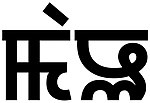of the Garo dialect Sino-Tibetan (or Tibeto-Burman) language which is also related to Koch, Rabha, Bodo other than Garo language. It is spoken in the...
14 KB (1,604 words) - 09:55, 15 October 2024
Look up Atong in Wiktionary, the free dictionary. Atong may refer to: Atong language (Cameroon), a language of Cameroon Atong language (Sino-Tibetan), a language...
444 bytes (88 words) - 15:51, 27 June 2023
identity. Ruga language shares similarities with other Garo languages. It is closely related to Atong language (Sino-Tibetan) and Koch language.Ruga speakers...
2 KB (159 words) - 16:14, 30 September 2024
subgroups of the Sino-Tibetan language family. This includes languages such as Garo language, Boro, Kokborok, Dimasa, Rabha, Atong, Tiwa, and Koch. Being...
23 KB (2,682 words) - 23:32, 9 November 2024
The Koch languages are a small group of Boro-Garo languages a sub-branch of the Sino-Tibetan languages spoken in Northeast India. Burling (2012) calls...
955 bytes (57 words) - 09:59, 15 October 2024
The Angami–Pochuri languages are a small family of Sino-Tibetan languages spoken in southern Nagaland and Northern Manipur of northeast India. Conventionally...
2 KB (142 words) - 19:43, 4 March 2024
as Tamu Kyi (तमु क्यी, tamu kyī; Tibetan: ཏམུ་ཀི) or Tamu Bhāṣā (तमु भाषा, tamu bhāṣā), is a Sino-Tibetan language spoken by the Gurung people of Nepal...
17 KB (1,576 words) - 23:15, 13 August 2024
Boro (बरʼ[bɔro]), also rendered Bodo, is a Sino-Tibetan language spoken primarily by the Boros of Northeast India and the neighboring nations of Nepal...
23 KB (2,084 words) - 23:42, 9 November 2024
It belongs to the Sino-Tibetan language family, but its position is unclear. Grierson (1903) classified it under Naga languages, Shafer (1974) and Bradley...
8 KB (601 words) - 14:17, 24 October 2024
Boro–Garo languages are a branch of Sino-Tibetan languages, spoken primarily in Northeast India and parts of Bangladesh. The Boro–Garo languages form four...
10 KB (788 words) - 23:39, 5 November 2024
Sema, is a Sino-Tibetan language spoken in Nagaland, India. It is spoken by the Sümi Naga people. It differs from every other Naga languages due to the...
6 KB (378 words) - 10:39, 29 February 2024
in the Tibetan script in 2001. Bhutia belongs to the Sino-Tibetan language family, and more specifically, is classified as a Tibetic language, descending...
30 KB (3,283 words) - 11:01, 14 November 2024
language(Northern Mizo) belongs to the Mizo language branch of the Sino-Tibetan family of languages. The speakers of this language use Mizo language as...
8 KB (599 words) - 01:46, 1 November 2024
Hakha Chin (redirect from Hakha-China language)
LaPolla, eds. The Sino-Tibetan Languages, 409–426. London: Routledge Lai languages Lai people how native Lai speakers call the language the official name...
15 KB (1,206 words) - 07:27, 22 November 2024
Nissi, Nyising, Leil, Aya, Akang, Bangni-Bangru, Solung) is a Sino-Tibetan language of the Tani branch spoken in Papum Pare, Lower Subansiri, Kurung...
7 KB (464 words) - 06:43, 28 July 2024
display. Maram is a Sino-Tibetan language spoken in India. The speakers of this language use Meitei language as their second language (L2) according to...
2 KB (100 words) - 11:13, 28 July 2023
Newar (English: /nəˈwɑːr/; 𑐣𑐾𑐥𑐵𑐮 𑐨𑐵𑐲𑐵, nepāla bhāṣā) is a Sino-Tibetan language spoken by the Newar people, the indigenous inhabitants of Nepal...
122 KB (10,302 words) - 13:46, 15 November 2024
primarily in the state of Arunachal Pradesh and Assam. These languages belong to the Sino-Tibetan family and include several major dialects such as Nyishi...
15 KB (1,500 words) - 04:22, 4 August 2024
Magar Dhut (Nepali: मगर ढुट, Nepali: [ɖʱuʈ]) is a Sino-Tibetan language spoken mainly in Nepal, southern Bhutan, and in Darjeeling, Assam and Sikkim,...
11 KB (630 words) - 00:39, 2 November 2024
you may see errors in display. Mao, also known as Sopvoma, is a Sino-Tibetan language of the Angami–Pochuri linguistic sub-branch. It is spoken primarily...
5 KB (285 words) - 08:28, 14 September 2024
other Siangic languages, harbour a non-Sino-Tibetan substrate, or may be a non-Sino-Tibetan language with Sino-Tibetan features acquired through prolonged...
3 KB (246 words) - 17:21, 17 November 2024
The Turung language is an endangered Sino-Tibetan language, closely related to Singpho, spoken in seven villages in central Assam. Many Turung people...
2 KB (145 words) - 00:59, 11 May 2024
of Austroasiatic that he calls "Rongic". Lepcha is a non-tonal Sino-Tibetan language, although it does have phonemic stress or pitch that may be marked...
25 KB (1,713 words) - 10:24, 13 September 2024
Kuki-Chin languages (also called Kuki-Chin-Mizo, Kukish or South-Central Tibeto-Burman languages) are a branch of the Sino-Tibetan language family spoken...
15 KB (1,286 words) - 21:50, 12 November 2024
Sound Changes within the Tenyidie (Angami) Language. 56th International Conference on Sino-Tibetan Languages and Linguistics, 10-12 October 2023. Chulalongkorn...
12 KB (916 words) - 09:36, 5 January 2024
Khiamniungan, also known as Khiamniungan Naga, is a Sino-Tibetan language spoken by the Khiamniungan people in Noklak district of Nagaland, easternmost...
5 KB (463 words) - 16:06, 12 September 2024
intended characters. Limbu (Limbu: ᤕᤠᤰᤌᤢᤱ ᤐᤠᤴ, yakthuṅ pan) is a Sino-Tibetan language spoken by the Limbu people of Nepal and Northeastern India (particularly...
18 KB (1,692 words) - 18:36, 8 November 2024
literary languages recognised by Sahitya Akademi, India's National Academy of Letters. Meitei belongs to the Tibeto-Burman branch of the Sino-Tibetan languages...
73 KB (6,185 words) - 05:02, 26 October 2024
not attested across the Sal languages, or have cognates in other Sino-Tibetan languages. Nevertheless, Matisoff (2013) accepts Burling's Sal group, and...
13 KB (1,219 words) - 02:03, 3 April 2024
The Tangkhulic and Tangkhul languages are a group of Sino-Tibetan languages spoken mostly in northeastern Manipur, India. Conventionally classified as...
6 KB (559 words) - 21:57, 13 January 2024










